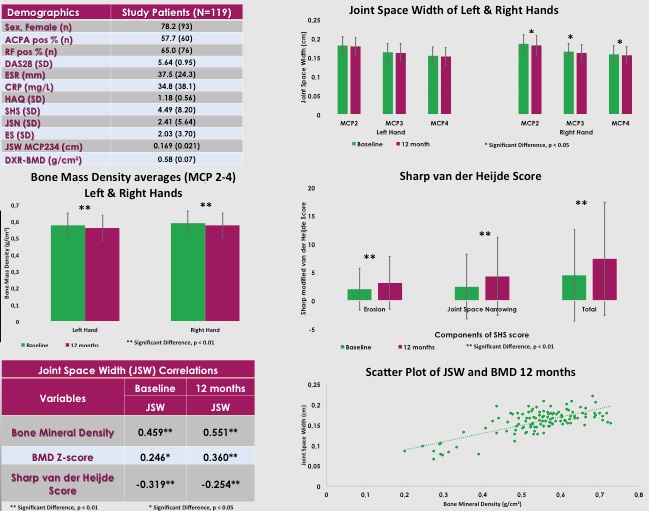Session Information
Date: Monday, November 9, 2015
Title: Imaging of Rheumatic Diseases Poster II: X-ray, MRI, PET and CT
Session Type: ACR Poster Session B
Session Time: 9:00AM-11:00AM
Background/Purpose:
Early prediction of radiographic
progression is beneficial in rheumatoid arthritis (RA) patient management. The
van der Heijde modified Sharp score (SHS) is currently the standard that
quantifies radiographic progression. The digital joint space width (JSW)
measurement (Kälvesten et. al, submitted 2015) is a quick method which may
offer a remedy to observer dependency and measurement error. Likewise,
objective quantification of hand osteopenia may be of value in the assessment
of bone involvement in early RA.
Methods:
Bilateral hand BMD and JSW measurements of
the metacarpals (2, 3 & 4) and SHS of early RA patient data, acquired from
the SWEFOT database were studied. Computer assisted automated measurements of
the MCP joint spaces were calculated from the hand x-rays using dedicated
software analysis. Hand BMD was assessed by digital x-ray radiogrammetry (DXR;
Sectra, Linköping, Sweden) of the same hand radiographs, scored with SHS at
baseline and at 12 months. The Z-score BMD was a calculated measure adjusted
for age and gender. Measurement differences of the ΔJSW,
ΔBMD scores, and ΔSHS
were established and correlated.
Results:
We studied 119 early RA patients (78%
female), with an average age of 53.6 years. In 714 joints (MCP2, 3 & 4
bilaterally), the automated JSW showed an average narrowing (ΔJSW)
of -0.0492mm from baseline to 12 months. The BMD displayed an average bone loss
of -0,0238g/cm2 from baseline to 12 months. A highly significant
correlation was evident for JSW and BMD averages (0.459, p<0.01; 0.551,
p<0.01) at baseline and at 12-month follow-up respectively. Even the ΔJSW
and ΔBMD over the 12 months demonstrated a
highly significant correlation (0.417, p<0.01). BMD Z-Scores showed similar
patterns with JSW (0.246, p<0.05, n=109; 0.360, p<0.01, n= 106) at
baseline and 12 months respectively. A positive inverse relationship emerged
between automated JSW and the joint space narrowing (JSN) component of SHS
(-0.319, p<0.01; -0.254, p<0.01) at baseline and 12 months respectively.
The average JSW measurements of both hands (n = 117) also revealed significant
correlations (-0.224, p<0.05; -0.271, p<0.01) with total SHS at baseline
and 12 months respectively. No significant correlation was found between JSW
and SHS erosion score. The 12-month BMD displayed near significant correlations
with the 12-month SHS erosion score (-0.174, p=0.060) and the 12-month total
SHS (-0.157, p=0.090).
Image/graph:
Conclusion:
Automated analyses of JSW
& BMD were technically feasible with reproducibility and agreement with the
SHS. Correlations between JSW & BMD and JSW & SHS were noted. An
inverse relationship between JSW and SHS narrowing score can be seen on
individual female joints. These objective, digitally quantified measures of
Joint Space Width and Bone Mineral Density may be useful as additional
complementary markers for early destructive radiographic progression in RA.
To cite this abstract in AMA style:
Platten M, Kisten Y, Kälvesten J, Forslind K, van Vollenhoven RF. Clinical Utility of Joint Space Width and X-Ray Radiogrammetry in RA: Markers for Early Radiographic Progression [abstract]. Arthritis Rheumatol. 2015; 67 (suppl 10). https://acrabstracts.org/abstract/clinical-utility-of-joint-space-width-and-x-ray-radiogrammetry-in-ra-markers-for-early-radiographic-progression/. Accessed .« Back to 2015 ACR/ARHP Annual Meeting
ACR Meeting Abstracts - https://acrabstracts.org/abstract/clinical-utility-of-joint-space-width-and-x-ray-radiogrammetry-in-ra-markers-for-early-radiographic-progression/

